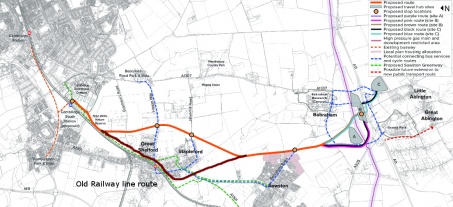UPDATE: 29 June 2020
The Greater Cambridge Partnership (GCP) Board approved plans, on 25th June, to proceed with a controversial building scheme between Cambridge Biomedical Campus and Babraham across Green Belt fields which would change the countryside forever.
A big thank you to all who wrote at the 24th hour to express their opposition to the scheme. Although this swell of opposition was noted, it was not enough to overturn the views of those on the GCP Executive Board which comprises; Cllr Aidan Van de Weyer (Chair) – South Cambridgeshire District Council, Cllr Roger Hickford – Deputy Leader, Cambridgeshire County Council, Cllr Lewis Herbert – Leader of Cambridge City Council, Claire Ruskin – Cambridge Network, Professor Phil Allmendinger – University of Cambridge.
The Magog Trust is not a campaigning body, but this issue affects Magog Down so directly that the Trust will continue to work with other bodies to oppose the plans for the bus route. Please continue to lobby your local representatives to request an opportunity for you to make your views known on the reinstatement of a scheme involving the old railway route.
At what cost our countryside?
Political leaders will make a decision, on 25 June, whether to press ahead with plans to proceed with a controversial building scheme between Cambridge Biomedical Campus and Babraham across Green Belt fields which would change the countryside forever.
It could be a forerunner of a Greater Cambridge Metropolis with the potential for a development corridor along the route reaching as far as Babraham. The new routeway would be for a bus only route initially, leading in time to the CAM or Cambridge Autonomous Metro.

The Greenbelt fields, which would be dissected by the route, are overlooked from Magog Down’s North Down, a site designated as an Asset of Community Value, offering unique views from its high point on Little Trees Hill, across landscape looking out towards the chalkland ridge of Royston Heath. The Down is home to our distant heritage, the Historical Monuments of ancient times: a Neolithic Causewayed Enclosure and Bronze Age Bowl Barrow.
Two new bridges will have to be built over the quiet stretches of the River Granta, a tributary of the River Cam, while existing roads in Sawston, Staleford and Great Shelford will carry additional sets of traffic lights to control the numerous passages of buses, maybe six per hour in each direction. Yet the route will pass by the furthest edges of development in all three villages, with little advantage to those living in these communities.
The latest GCP reports show that using the old Cambridge-Haverhill railway line could be used as an alternative route. There would be difficulties to overcome and it would be more expensive but this route would save damage to the countryside, and would better serve the communities of Stapleford and Great Shelford. So far, the public and stakeholders have not had the opportunity to give their views on this option of using the old railway line (shown in dark red on our annotated version of the GCP’s route overview, below).

Yes, it could be £30m more expensive, but what price is our countryside and landscape for future generations? And who decides what value it has?
There is a less-damaging alternative route possible and we are calling on the GCP to pursue this further. We are encouraging others to do so as well.
You can find out more detail on the GCP website, and further links from that. The overall budget for the scheme is currently shown as £132 million, of which £22 million is designated to Project Management and Design.
